A Telehandler Forklift also known as a telehandler handler, telescopic handler, teleporter, or rough terrain forklift, is a vehicle with an extendable boom, which can be extended forward and upward from the vehicle, so it can be equipped with various lifting equipment.
Telehandlers have several attachments, such as a winch, pallet forks, muck grab, or bucket, and can be used for material handling, and personnel elevation. A telehandler can be rented by the day, week, or month.
Telehandlers are widely used in construction, agriculture, industry, mines and quarries, environment, logistics, and other markets. When you want to rent, buy or sell you can find it with these names on the web pages:
- Extended forklift
- Telescopic lift
- Teleporter forklift
- Telescopic loader
- Telescopic forklift
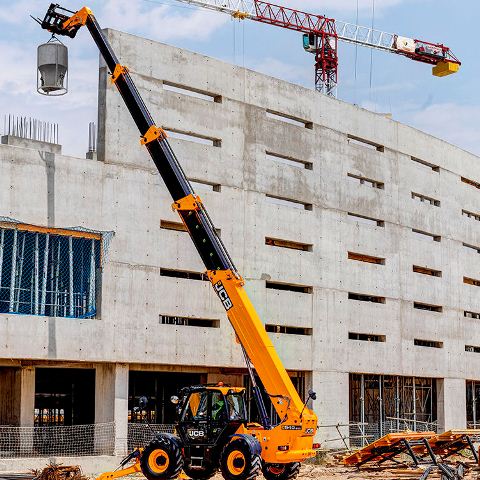
What is a telehandler forklift?
Telescopic forklift:
Telehandlers (also known as Rough Terrain Telescopic Handlers or Variable Reach Trucks) make a valuable contribution to the construction process by enabling materials to be unloaded from delivery vehicles, transported around construction sites, and placed at height (reach).
They are versatile machines that can be fitted with a wide range of attachments such as buckets, skips, work platforms, and crane jibs.
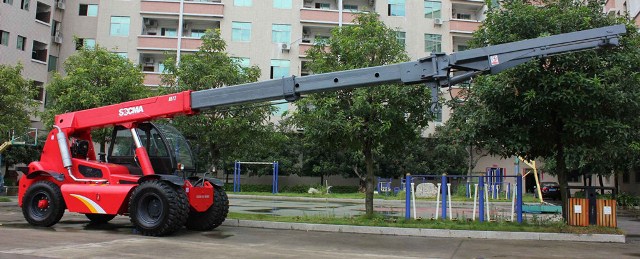
Forklift telehandler for Rent
Whether used for agricultural applications or on a construction site, a telehandler forklift is one of the most common industrial pieces of equipment. Despite its frequent use, however, many people confuse these vehicles with forklifts or cranes.
A telescopic handler provides some of the benefits of each of these pieces of equipment, making it suitable for a variety of tasks.
With this guide, you’ll learn more about telehandlers, including how they’re used, popular telehandler models, how much does the rent cost? and safety tips for using them.
But first, take a closer look at some of the basics of telehandlers.
To find a line of telehandlers available, although availability will vary based on your location, the following are some examples of the types of telehandler models you can find for rent:
Rotating Telehandler
Rotating telehandlers have all of the features of the non-rotating type with the addition of a rotating or slewing superstructure on which the boom and operator’s cab is mounted.
These machines also have outriggers fitted at either end of the chassis which enable the entire chassis to be lifted clear of the ground for maximum stability.
The main advantages of these machines over the non-rotating type are compact chassis size, enhanced lifting height, increased stability, and ease of placing loads without moving the chassis.
All telehandlers can be fitted with a wide range of attachments such as buckets, skips, work platforms, and crane jibs.
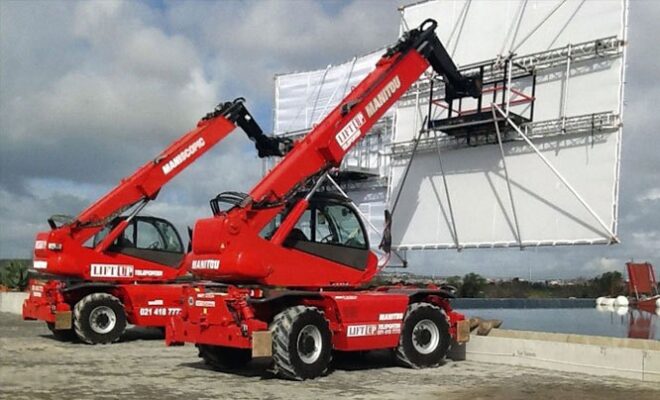
Heavy lift telehandler
Non-rotating telehandler
These machines comprise a powered wheeled chassis onto which is mounted a telescopic boom, pivoted on the chassis, which can be elevated from below the horizontal to an angle approaching the vertical. The outer end of the boom is fitted with a fork carriage and forks for handling unit loads. Leveling of the forks in the longitudinal plane, as the boom elevation changes, is carried out automatically.
These machines are able to transport loads from one part of a site to another and place the load at height. On construction sites, the wheels are generally fitted with lug grip tires to enable the chassis to negotiate unpaved ground. Many telehandlers are fitted with stabilizers which are deployed when the machine is stationary to provide additional stability and enhance the machine’s lifting capacity.

Construction forklift telehandler
It is essential that in managing the use of telehandlers, adequate attention is paid to all aspects of the process – selection of the correct equipment for the application, planning its use by competent people, monitoring the activity and rectification of issues; if anyone aspect is ignored the probability of an incident will increase significantly, putting both the machine operator and people in the vicinity at risk.
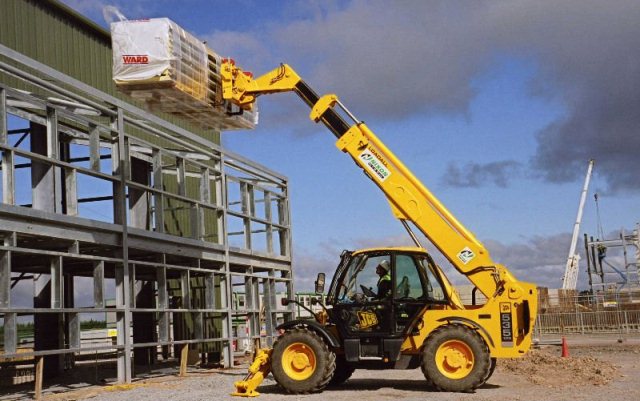
Forklift extensions
An effective and safe telehandler is one that is well matched to the type and size of load to be carried and lifted, together with the environment in which it is to be used. Attachments for use with telehandlers should be chosen with care to ensure that the combination of telehandlers and attachments is both safe and productive.
It is essential that all attachments are compatible with the telehandler with which they are to be used. Where necessary and appropriate, the telehandler manufacturer should be consulted when third-party attachments are to be used. The selection of the telehandler and any attachments should be part of the planning process.
The Provision and Use of Work Equipment Regulations require that employers ensure that work equipment provided for their employees is the most suitable for the purpose for which it is being used and reduces or eliminates risks to the user and other people.

Telehandler safety
Unfortunately, there have been a significant number of accidents involving the use of telehandlers, which have tragically included a number of fatalities. *
Safe Use of Telehandlers
Two of the most significant hazards associated with telehandler operation are lateral stability and visibility.
Lateral stability
As a load on the forks of a telehandler is lifted, the center of gravity of the whole machine rises.
This does not matter if the machine is level: if however, the machine is on a cross slope, the center of gravity will move towards the tipping line as the load is raised with a risk of overturning. This effect is exacerbated when the telehandler is driven with a raised load. Lateral stability is also an issue when lifting and traveling with suspended loads as the load may swing, adding to potential instability.
Visibility
Restricted visibility when the boom is raised or when large loads are carried, plus poor segregation has been identified as a major cause of accidents involving pedestrians and telehandlers.
Telehandlers are often fitted with aids to improve visibility and the operator’s awareness of people in the vicinity of the telehandler.
These aids should be in good working order and properly adjusted. It is the operator’s responsibility to check the condition of all secondary aids to visibility and NOT TO USE THE MACHINE if they are not present or not working correctly. It is the Supervisor’s responsibility to fully support the operator in this action.
Whilst the Principal Contractor has the primary responsibility to ensure adequate segregation and the Supervisor must ensure that it is enforced, it remains the operators’ responsibility to look around and check for the absence of pedestrians before moving and whilst maneuvering and traveling.
- If the operator cannot see clearly, they should seek assistance or leave the cab to look around to confirm it is safe to continue the procedure.
- Wherever possible pedestrians should be segregated from moving vehicles, including telehandlers.
- Visibility aids and operator vigilance are valuable control measures, but segregation should always take priority.
- Thought should also be given to the operator’s ability to keep the load in view at all times, particularly with high reach telehandlers where the operator may have difficulty in judging distance at height
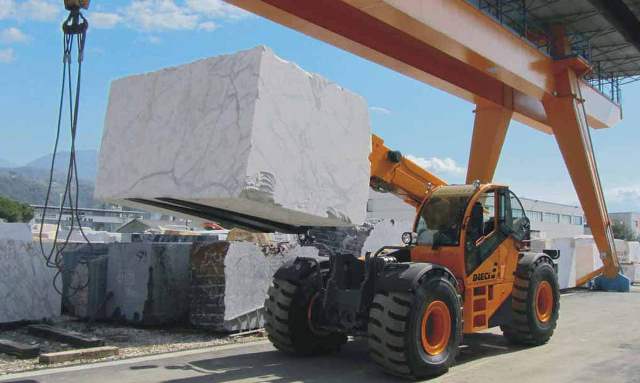
Forklift maintenance procedure
Maintenance and Inspection
The effective maintenance of a telescopic forklift is an essential part of safe operation. As with all machines, a telehandler will wear, deteriorate, and can suffer damage over time.
The maintenance process, including checks and inspections, monitors, prevents, and rectifies this deterioration. It is important that the person asked to carry out these tasks has the necessary machine-specific training, experience, and competence in both periodic and breakdown maintenance.
Telehandlers require the manufacturer’s preventative maintenance instructions to be strictly complied with if safety is to be maintained in use. Checks and inspections should be carried out taking into account the frequency of use of the telehandler and the environmental conditions in which it works.
Both the user and owner of the telehandler and any attachments used with it, have a responsibility to ensure that they are maintained in a safe working condition. In practice, the maintenance, other than pre-use checks, is normally undertaken by the telehandler owner on behalf of the user.
Teleporter forklift Design
Design Principles:
The scope of this Standard very clearly states that it applies only when the telehandler is stationary and lifting on substantially flat, level, and compacted ground or traveling with a load. It also applies only to use with forks. Consequently, if a telehandler is used in other circumstances such as traveling or lifting on slopes or with attachments other than forks, the additional risks need to be reassessed.
As part of the test process to ensure conformance with the Standard, telehandlers are placed on a platform, which must be tilted to preset angles to assess stability. Across the slope, and with a rated maximum load at full lift height*, this angle is only 7°. Most telehandler operators and supervisors, when asked, estimate that it is in the region of 25°- 30°, which is a significant overestimate.
*The procedure is somewhat more complicated than this in reality

Telehandler lift
With the rated load in the traveling position, the minimum tilt platform angle required is somewhat greater at 26 degrees. However, it is clear that raising the mass of the boom and/or load greatly decreases stability.
Because telehandlers normally have freely oscillating rear axles, the tipping lines form a triangle, rather than the rectangle of machines supported on outriggers such as rotating boom telehandlers and mobile cranes. This has the effect of reducing lateral stability, particularly with the boom raised.
All the stability tests carried out on telehandlers during their design and development are performed with a standard load which consists of a cube with 1-meter sides. Using a load with physically larger dimensions, or which is not homogeneous, presents extra risks that must be assessed.
To maintain stability a telehandler:
- Should only be used on firm ground that resists sinking of the wheels or stabilizers (if fitted);
- Should lift vertically, either being on level ground or using a frame leveling feature;
- Maybe less stable with a different shaped load;
- Should be stationary with the brake applied, for all “normal” lifts;
- Should only be used by a trained, certificated and competent operator.
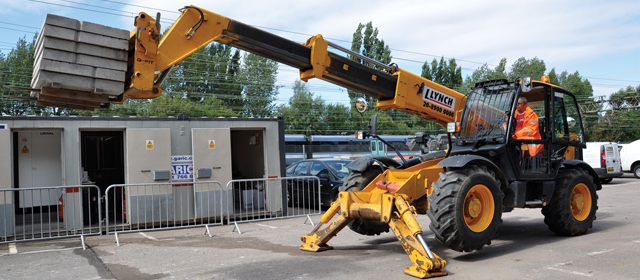
Telehandler Tyres
The Effect of Tyres on Stability: Tyres play a vital part in the stability of telehandlers. Stability and load-carrying capacity can be adversely affected by issues such as:
- Incorrect tyre pressure
- Differences in the diameter of tyres on the same axle due to differential wear
- Incorrect ply rating
- Use of tyres which are not of the required performance specification
- Tyres with identical nominal sizes being of different physical size
- Poor tyre repairs.
Load moment indicator
From the first designs in the mid-1970s, telehandlers have been fitted with a device that monitors the tendency of the telehandler to tip over in the forward direction. The correct name is a Longitudinal Load Moment Indicator – LLMI.
It’s vital to understand the functioning and, particularly, the limitations of this device. First, and most important, it is not a Safe Load Indicator!
The LLMI works by sensing the load upon the back axle. As the load on the forks is increased, or the boom extended, the load moment (load x distance) increases and the rear axle becomes ‘lighter’. At a preset value, the LLMI sounds and shows a warning. However, the LLMI only senses forward stability, not rearward or lateral stability and it is essential that operators understand this limitation.
Some manufacturers have linked this with a control device, which blocks further destabilizing motion when the stability limit is approached. In this case, the device is called a Longitudinal Load Moment Control or LLMC. These are fitted on a new telehandler manufactured after September 2010, however, there is no requirement to retrofit on older machines.
Telehandlers for sale
Previous models for rent, for sale, new or used have to be reviewed in more detail by exploring the equipment. You’ll find all kinds of written and video reviews from renters, landlords, and industry experts for various models of telehandlers when you search online.
Telescopic forklift training
Driving with the Boom Raised
Telehandlers should always be driven with the boom lowered to ensure that the center of gravity of the machine and the load are as low as possible. Driving with the boom raised should never be considered as “normal” practice, for all of the above reasons. It introduces an extra risk that must be assessed.
If the site is so restricted that maneuvering is impossible without raising the boom, site management should re-assess the use of a telehandler at all or, at least, consider the reselection of the machine chosen. In the past, operators have raised the boom in order to see under it.
The modern design of telehandlers makes this unnecessary and regular driving of a telehandler with the boom raised should ALWAYS be challenged by supervisors.
Suspended load safety
Lifting suspended loads
Telehandlers are often used to place suspended loads into position. The standard rating of a telehandler is for lifting unit loads on the forks; consequently, the standard load chart will not be valid for lifting suspended loads due to different load centers and the effect of any side slope.
From 2010 newly manufactured machines should be fitted with a longitudinal load moment control (refer to operator’s manual), and indication will be provided to the operator regarding longitudinal stability when stationary and the operator will be prevented from operating the machine outside of the limits determined by the manufacturer. Such machines may provide additional safety when lifting suspended loads.
Telehandler forklift driver
Travelling with suspended loads
Traveling with a suspended load involves traveling with the boom raised from the normal transport position, with additional dynamic forces due to the swinging of the suspended load.
If the information for traveling with a suspended load is provided by the manufacturer and the activity is permitted by the site, the following points should be adhered to:
- The boom and load should be kept as low to the ground as practicable (load 300-500mm above the ground). To facilitate this the correct length of chains, slings, etc. should be selected.
- If necessary the boom should be extended from the fully retracted position by the minimum amount required to ensure that the load does not interfere with the front of the telehandler chassis. It is essential that the load radius remains within that allowed by the load chart for the magnitude of the load being lifted.
- Visibility may well be reduced and planning should identify appropriate control measures, such as a marshaller to guide the operator.
- Any load swing must be minimized by the delicate use of controls and slow travel speeds.
- Operators should take care when braking and/or turning as this creates dynamic forces transmitted to the boom, thereby reducing stability.
- Slinger/signallers and other personnel should never walk in front of the telehandler to steady a swinging load as it is very easy to trip, fall and be crushed by the telehandler wheels.
Telehandler operator
- The machine should travel extremely slowly and never above walking pace.
- The operator should follow the manufacturer’s instructions for traveling on slopes and inclines. It is essential that they do not attempt to climb, descend, or cross inclines in excess of manufacturer’s limiting values, as this significantly increases the likelihood of overturning.
- Lightweight but bulky items like roof trusses pose a special risk. Although relatively light, they are physically large, leading to large dynamic forces and are significantly affected by the wind. Physical restrictions on-site may require the boom to be elevated in order to clear fixed obstructions. Any carrying and placing of such items with a telehandler carries a significant extra risk that must be addressed by the site risk assessment.
- Care should be taken to avoid overhead obstructions including overhead power lines.
How much does it cost to rent a telehandler?
Prices are quoted per day, week or month. It depends on the capacity of the forklift which ranges from 5,000 to 20,000 pounds and the average rental price is 200 to 400 dollars per day, 600 to 1,200 dollars per week, and 1,500 to 3,200 dollars per month.
In the industrial sector, the most common telehandler attachment is pallet forks. The telehandler is used to move loads to and from places unreachable for a conventional forklift. For example, they can remove palletized cargo from inside a trailer and place those loads on rooftops and other high places.
A telescopic handler, also called a telehandler, teleporter, reach forklift or boom lift is a machine widely used in agriculture and industry.
The most read
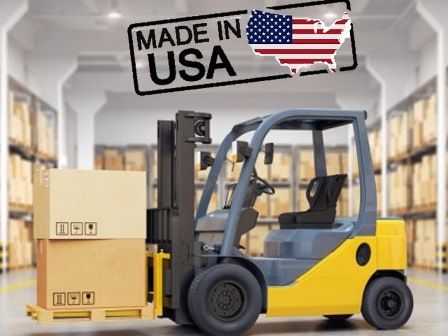
Forklift Manufacturers
Because there are so many forklifts on the market, one of the best ways to start narrowing down your options is to consider the top forklift manufacturers and suppliers.

Marine Forklift for sale
Large marina forklift picking up a boat
